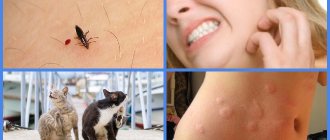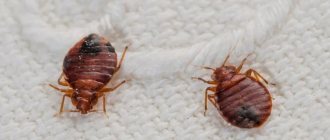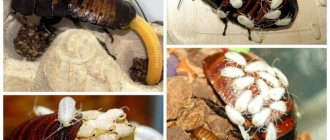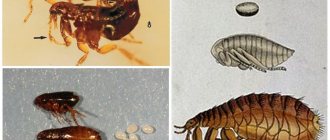How long do fleas live in an apartment, how many days do they die after treatment, why do they not die even when the animals are no longer in the house - the answers to these questions lie in the biology of the parasites.
How long a flea can live without feeding on blood outside an animal depends on environmental conditions and the stage of the insect's life cycle. First, let's establish how many years, months or days earth fleas can live in different circumstances - favorable and extreme.
How long do fleas live in artificial conditions?
In the laboratory
In laboratory conditions, adult cat fleas live for months. In one artificial system, the maximum lifespan was 86 days. In another experiment, when fleas were fed human blood, their lifespan reached 139-185 days!
On an animal
The flea lives on the body of the owner for a long time, provided that the animal does not take care of itself. For example, one experiment showed that 94.1% of females and 89.2% of males survived for 14 days on cats. In another experiment, cats had their nails trimmed and were given conical collars to prevent grooming. After 50 days, 85% of females and 60% of males were still alive. And after 113 days, 76% of females and 50% of males were still living on cats.
Flea bites
Adult human fleas feed exclusively on the blood of people and animals, so their presence in a room is always first signaled by bites.
- A flea bite is felt immediately as soon as the insect pierces the skin with its proboscis.
- A flea bite causes an intense piercing-burning sensation at a specific point.
- Redness appears at the site of the bite, the area may swell and almost immediately begins to itch severely.
- People and animals often scratch flea bites until they bleed, since even soothing ointments and creams are sometimes unable to relieve their itching.
- Fleas feed around the clock and are especially unpretentious in choosing places to bite.
If you have fleas, consult a doctor and get the necessary tests to eliminate the possibility of contracting dangerous infections and parasites.
How long do fleas live and how do they die in natural conditions?
Animal hygiene habits are the main factor in flea mortality
In real conditions, 95% of fleas die as a result of the host animal grooming itself. Unlike temporary parasites, such as mosquitoes, fleas, after feeding on blood, remain on the host’s body, where they live permanently. Therefore, the instinctive care of animals for their fur is the main cause of death of parasites. On the other hand, on the animal's body, fleas are protected from exposure to harsh environmental conditions.
How many fleas do cats clean?
Cats kill over 50% of adult fleas per week, averaging 3-12 per day. In one study, cats cleared 19.5% of female and 38.5% of male fleas in a week. In three weeks, a cat can remove 90% of fleas from its fur. Only 2-3% of insects will survive longer than this period. But some individual parasites manage to avoid purges and not get caught. There was a recorded case where a flea lived on an animal for 9 weeks.
How long does a cat flea live without a cat?
If a cat finds a flea, it eats it - this is how the vast majority of the parasite population dies. A small percentage of them end up released into the external environment. During cleaning, discarded fleas receive damage that causes them to die - their heads or paws are torn off. However, the body of an adult flea is tough and elastic, so some of them survive. But if after a couple of days the discarded fleas do not return to the host’s body, they will die of starvation.
Some animals groom themselves more thoroughly than others.
Sensitivity to fleas varies among individual animals. Some brush constantly, while others tolerate small to moderate amounts of fleas. The sensitivity factor directly affects the degree of parasite infestation. Animals that do not tend to groom their fur are preferred hosts for fleas. Those pets who are allergic to fleas clean themselves meticulously and quickly reduce the degree of infestation.
One study looked at the hygiene habits of four cats. The least active removed 4.1% of fleas per day (22% per week) from fur, and the average lifespan of parasites was 18 days. The cleanest cat cleared 17.6% of fleas daily (68% per week), allowing them to live an average of 5 days.
Animal age factor
Young animals tend to have larger flea populations than adults. This is due to the fact that young cats still lack experience in fighting parasites. In addition, adult cats have better developed immunity, thicker skin, and differently located capillaries.
Important Factors
- The influence of air humidity - individuals live longer if the air humidity is lower. Humidity is an important factor on which the life of an insect depends, but temperature indicators are more important for them. That is why an excellent place for them to live is the basement in an old apartment building, where utilities are leaking.
- The lifespan of parasites depends on the availability of food sources; individuals can starve for a long time, and the lifespan during hunger strike can, in some cases, increase.
- Physical indicators of the habitat also affect the life of bloodsuckers. With static temperature fluctuations, individuals can hibernate. Under such living conditions, the lifespan of the insect increases.
The success of reproduction of individuals depends on time, the speed of the process and the number of eggs produced by each individual individual. When exterminating fleas, it is worth carrying out global baiting; both adult individuals and their nits must be destroyed. Thus, now you know how long a flea lives and how to completely destroy it in a short time.
How long does a flea live outside an animal at extreme temperatures?
Cold and frost
Sub-zero temperatures are lethal to fleas. At temperatures just below zero, adults emerging from cocoons die within 5 days. At 3-5 degrees above zero, fleas die within 10 days. The lower limit of survival is +8 degrees - at this temperature, 50% of fleas survive for 20 days. So in winter, fleas cannot live outside without an animal. Immature fleas are more sensitive to cold than adults. Eggs and larvae will not develop if the temperature does not exceed +13 degrees.
Heat and dryness
Heat above 35 degrees is deadly for fleas. At low relative humidity, fleas die within 2 days. In addition, the larvae die inside the cocoons at this temperature. The flea population does not survive outdoors if the heat above +35˚C lasts more than 40 hours during the month.
Lifespan of fleas
How long do fleas live on animals and can they survive without them? The answer to this question lies in the living conditions of insects. Let's take a closer look at where and how long fleas live.
In the laboratory
When studying these insects, scientists tried to find out exactly how many days a flea can live if it is provided with ideal living conditions. It turns out that these insects love warmth - at least +250C and air humidity of about 60%. As a result of the experiments, it turned out that fleas live up to 90 days without food.
Flea
In the case when fleas were fed with blood from laboratory animals, the insects lived from 140 to 180 days. Of course, under normal conditions fleas live much shorter lives.
For reference! If a flea constantly lives in a warm environment, then it grows larger than those insects that are forced to live in the cold.
On an animal
The lifespan of a flea on a cat or dog directly depends on whether the animal cleans fleas on time or for some reason cannot do this. Each animal species has its own type of flea parasite and they are all well adapted to the characteristics of their host.
For example, the chicken flea prefers an environment temperature of about +400C and humidity up to 80%. And rat fleas reproduce easily at temperatures of +150C and humidity up to 60%.
Cat fleas are very dependent on the surrounding temperature - if it sharply increases or decreases, then they stop reproducing and begin to die. At a temperature of +380C, fleas can live only 3-4 weeks. True, during this time they will have time to leave numerous offspring. Each mature female flea can lay up to 500 eggs.
In addition, if the animal does not remove fleas on its own, they can live on it for up to 1.5 months.
On average, parasites live on animals from 20 to 30 days.
Without a master
It’s easy to answer the question - how long do fleas live without an animal if you know the physiology of insects. Although female fleas are very fertile, they need to regularly consume animal or human blood to continually lay eggs.
For reference! Although there is also a species of “human” fleas, these insects still prefer the blood of animals, since humans do not have fur in which to hide. They attack people only when there are no cats or dogs nearby.
If a flea does not find an animal to feed on, then it can live for only 2 months in an apartment at temperatures above +15...200C. At the same time, she will not lay eggs.
When cats brush fleas, some fall to the ground. In this case, in outdoor conditions outside the animal, the flea will not live for even a few days, especially if it is cold outside.
Animal age factor
Fleas on cats can live no more than 3 months. The younger the animal, the more insects it lives on. This is explained by the kitten’s inability to catch and clean fleas. Also, adult animals have much thicker skin and it is more difficult for insects to bite through it.
Blood addiction threshold
In adult fleas, there is a phenomenon associated with the physiological process of getting used to consuming fresh blood - the addiction threshold. As soon as the flea reaches it, it runs the risk of dying if it accidentally loses its host. The usual time to reach this threshold is 5 days of daily blood consumption.
Infected animal
As a result of experiments, scientists found that fleas removed from a cat or dog die without food within 2-4 days. If the threshold of dependence has not been reached, then fleas without a host can live up to 2 weeks.
In extreme conditions
The life expectancy of a flea in frost and cold is extremely low - insects die in a matter of days. For example, fleas that have just left the cocoon live only 4-5 days at temperatures down to -50C. If the temperature rises to +80C, then half of the parasite population lives up to 20 days.
Therefore, in winter, a flea definitely needs a carrier - a warm-blooded animal with thick fur. The development of larvae and eggs slows down if the ambient temperature is less than +130C.
The lifespan of fleas in hot and dry conditions is not as long as it seems. Although fleas love warmth, already at a temperature of about +400C and an air humidity of 30-40%, part of the flea population can die within 2 days.
In such conditions, even larvae that did not have time to emerge from their cocoons die. On the street without animals, fleas completely die in the summer heat at temperatures above +350C, if it lasts more than two days in a row.
How long can adult fleas live without food?
After emerging from the cocoon
At home, adults newly emerging from cocoons must drink their first blood within a week so as not to die of hunger. In a number of experiments they survived longer, but two weeks is the ceiling. 95% of young hungry fleas at +24˚C and a relative humidity of 78% die in 15 days, and at +22.5˚C and a relative humidity of 60% - in 12.3 days.
Fleas that do not feed on blood survive much longer, up to 40 days, in a humid environment at relatively low temperatures. In cool, damp air (62%), young fleas will live even 70 days without animal blood. But such conditions are found only in the basements of apartment buildings, and not in residential premises.
Discarded from the owner
Once on the host, fleas immediately begin to feed. During the day, the insect doubles in size and triples the supply of proteins in the body. Once thrown from the animal, the flea loses its accumulated weight and protein supply within 12 hours. After 12 hours of fasting, death can occur as a result of malnutrition. If fleas only have access to food for 2-3 hours a day, they are malnourished.
Blood addiction threshold
When feeding on a host, at a certain point fleas pass a point at which they require a constant source of blood to survive. This is reminiscent of drug addiction. Males removed from the animal after 5 days of feeding die within 48 hours, and females die within 96 hours. Survival outside the animal increases sharply (up to 14 days) if the initial feeding period is limited to 12 hours, since in this case the dependence threshold is not reached.
How to fight fleas
The best treatment is prevention, so you need to take care to regularly treat your pets with special medications and make sure they wear flea collars (which should never contain amitraz, permethrin or organophosphates.)
However, if your home has already been attacked by parasites, before disinfecting you need to make sure that it is fleas and not mosquitoes or bedbugs that are bothering you. To do this, place sheets of paper in the dampest places in the house. If after 15–20 minutes brownish-black insects appear on the paper and disappear with the slightest shaking of the sheet, you can begin removing fleas.
It is useless to destroy individual individuals when a room is infected. To get rid of parasites, you need to carry out thermal and chemical treatment of things belonging to pets (bedding, scratching posts, etc.), thoroughly wash bedding, vacuum and, if possible, dry carpets in the sun.
Chemical preparations will help remove fleas, as well as folk remedies - tansy and wormwood. The premises should not be cleaned for a week after treatment. If fleas are not active within two to three weeks, then there are no more insects in your home.
If independent actions do not help, turn to disinfectants: this is the most expensive, but also the most reliable way to get rid of any parasites in the house.
Where do fleas live in an apartment if there are no animals (photo)
For the full development of a flea colony, the presence of furry animals or birds is necessary. If adult parasites accidentally end up in an apartment where there are no animals, they will live for some time on human blood.
In the absence of animals, the habitat of fleas in the apartment is limited to shaded, cool areas on the floor, where they are not too noticeable.
Can fleas live in hair and on the human body?
Fleas do not live on humans, unlike head and pubic lice; after feeding on blood, they immediately leave the human body. If a flea is disturbed while feeding, the insect may linger on the clothing on the underside. In rare cases, the flea remains in clothing for 1-2 days without finding a way out, and periodically bites. Fleas do not prefer humans as hosts due to their scanty hair.
Why does a flea need an owner?
It is a mistake to think that blood-sucking insects constantly live on cats, dogs and other pets and, if necessary, can “jump” on humans. For these parasites, mammals are only a source of food; they feed on their blood and are temporarily present where they eat. For reproduction, which occurs regularly in fleas, they need to find a cozy, quiet place not far from the “feeder”:
- Animal bedding
- Rugs, carpets
- Gaps in the floor and behind the baseboard
- Old things
- Accumulations of trash and dust
In order not to be far from the food source, fleas settle directly into the animal's bedding
Important: You can find parasites not only on the host: they also exist perfectly well outside his body. The insect jumps off the animal or person immediately after saturation (after a few minutes or hours), and only because of the high flea population it seems that they live on the host permanently.
How long do flea eggs and larvae live and where do they live?
The secret of the survivability of these parasites lies in the early stages of the life cycle. As you know, fleas go through 4 stages of development, starting with the egg.
How long does it take for flea eggs to hatch?
In an apartment, most flea eggs end up in floor carpets and animal bedding. Hatching eggs requires a combination of suitable temperature and humidity, and the microclimate inside the carpet pile is ideal. In an apartment at room temperature, the larva emerges from the egg after 2-3 days. In less comfortable conditions, the period of egg development lasts 8-12 days.
How long does it take for flea larvae to develop?
The development period of the larvae, depending on the conditions, varies from 5 to 45 days. In addition to comfortable temperature and humidity, flea larvae need sufficient food. The larvae feed on semi-digested dry blood, which is excreted in the form of excrement by the imago. In an apartment where an infected pet lives, carpets and bedding are replete with both eggs and flea excrement.
As a rule, in an apartment the period of larval development before pupation is 7-12 days. In a cooler and drier environment and with poorer nutrition, the larvae develop in 28-45 days.
How long does the pupal stage last?
The pupal stage consists of three stages: prepupa, pupa and preimaginal stage. These stages take place inside the cocoon and usually last 7-19 days in total. Males develop 14-20% longer than females. With a decrease in environmental temperature, the period of development of the pupa increases. For example, at a temperature of 27˚C the female develops in 8 days, the male in 10 days, and at a temperature of 15˚C the female develops in 27 days and the male in 32 days.
The timing of pupal development is also affected by relative humidity and how well the larva has been fed. The more abundant the food was at the larval stage, the longer the pupal stage lasts. This is due to the fact that the biological mechanism for exiting the cocoon is triggered when the level of fluid and nutritional reserves of the body reaches a critical level. In one experiment, a larva that was starved before pupation passed through the pupal stage in 8 days, and a larva that fed abundantly passed through the pupal stage in 56 days.
But the pre-imaginal stage, when an adult flea has developed from a larva but has not yet emerged from the cocoon, can last much longer - up to 5 months. The trigger for the exit of the imago from the cocoon is the presence of the future host, which insects recognize by temperature and pressure when they step on it. The flea will not leave the cocoon until it receives these signals.
What are fleas afraid of?
The greatest danger to insects comes from substances that act to destabilize the nervous system. Fleas, like many other insects, are afraid of smells. In other words, insecticidal agents force them to leave their owner, no longer jumping on him. Insecticidal agents develop paralysis, which leads to a stop in the movement of plasma in the body, resulting in death.
These parasites are also afraid of the cold; they cannot reproduce at -10 degrees. Often in winter, bird sheds freeze out. Water is a dangerous environment for insects. Therefore, frequent baths for animals reduces the number of animals in the household.
Insects do not perceive strong odors. Apartment renovations using paints, varnish, solvents, cement and putty cause insects to migrate.
There are plants in nature that also repel them:
- sagebrush;
- walnut oils, camphor, aloe;
- spruce, pine, juniper;
- eucalyptus;
- tansy;
- carnation;
- thyme;
- Ants attack flea larvae and are therefore considered their potential enemies.
How quickly do fleas die when treated with insecticides?
After synchronous treatment of the premises and pets, flea imagoes die within 1-2 days. But the insecticide does not penetrate deep into the carpet, where eggs, larvae and pupae hide. In addition, the cocoon reliably protects the pupa from chemical exposure.
After how many days should I re-treat fleas?
When using long-acting contact preparations, adults emerging from cocoons will die within 3-4 weeks. However, over time, the properties of the chemical weaken. It is recommended to re-treat the premises after 2-3 weeks. As a rule, two or three treatments are enough to remove a colony of domestic fleas.
Reproduction and development
The life cycle consists of four stages. First it is an egg, then a larva. From this state, the parasite enters the pupal stage, from which an adult emerges. Within a couple of days after mating, the female will lay eggs.
Unlike some other insects, whose eggs are covered with a sticky substance, in fleas they simply fly away in different directions, as they are pushed out of the body with force. Often you can see dirt on the animal's skin, which is actually excrement.
Feces are released when the eggs are released. If they get wet, they may turn red because they are essentially processed blood. At one time, the flea lays from 3 to 15 eggs, but it is not able to do this every day.
Video
Sources:
- Wade, SE & Georgi, JR Survival and reproduction of artificially fed cat fleas, Ctenocephalides felis Bouché (Siphonaptera: Pulicidae) // J. Med. Entomol. 25, 186–190 (1988)
- Kern, W.H., Koehler, P.G. & Patterson, R.S. Diel Patterns of Cat Flea (Siphonaptera: Pulicidae) Egg and Fecal Deposition // Journal of Medical Entomology 29, 203–206 (1992)
- Rust, M. K. Interhost movement of adult cat fleas (Siphonaptera: Pulicidae) // J. Med. Entomol. 31, 486–489 (1994)
- Hinkle, NC, Koehler, PG & Patterson, RS Host Grooming Efficiency for Regulation of Cat Flea (Siphonaptera: Pulicidae) Populations // Journal of Medical Entomology 35, 266–269 (1998)
- Dryden, M.W. Host association, on-host longevity and egg production of Ctenocephalides felis felis // Veterinary Parasitology 34, 117–122 (1989)
- Dryden, M. W. Biology of Fleas of Dogs and Cats // The Compendium on Continuing Education for the Practicing Veterinarian 15, 569–578 (1993)
Dmitry Lipchiu
Please rate the material
Without food
Usually, a daily one-time meal is enough to satiate, but if the meal cannot be completed, the flea jumps on the animal again. In this case, insects can starve for a long time.
An individual emerging from a cocoon can search for a host for about two weeks. All this time she goes without food. You should not hope that after leaving the apartment for a while, you will be able to wait for all the fleas to die and return to a clean house. They can go without eating for up to a year and a half, so they will have to travel for a very long time.
Pupae can wait even longer for their future owner. They will feel its approach by the vibration of the floor. The victim can be used to satisfy hunger and move to a more favorable place - where there will be a cat, dog or bird. Cat, dog and chicken fleas cannot constantly feed on human blood.
An insect that is left without a food source does not fall into suspended animation; it is still mobile, but is deprived of the ability to reproduce. It turns out that during the absence of the owners, there will be no more fleas in the apartment, but they will live and patiently wait for the return of people and their pets.
Characteristics of fleas
The flea is a parasitic wingless blood-sucking insect, beautifully called in Latin “Siphonaptera”. The average static insect of this species is from one to five millimeters in size. The color of adults is brown, juveniles are often black, but there are also separate subspecies, the color of which varies from straw to black-brown.
The body of the parasite is equipped with multiple bristles and spines, and is flattened on the sides, due to which the insect has an incredible ability to stay on the fur of animals, in the folds of clothing, between the wings of birds, in the substrate of burrows and nests. In addition, fleas have three pairs of legs, the back of which plays the main role during jumping. Such a construction of the limbs of this insect allows it to freely cling and move around the host’s body at any angle.
Methods for eliminating fleas in animals
Pets must be treated first. There are many means for these purposes.
Special shampoos . The product is applied to the pet’s fur while bathing, after 3-5 minutes it is washed off with clean water, then the animal must be thoroughly combed.
Sprays and drops are very effective in controlling fleas. The drops should be applied to the animal's skin along the ridge to prevent the drug from being licked off. The spray is applied to the entire coat by spraying.
Temperature that kills insects
Scientists consider fleas to be one of the most dangerous and very annoying insects. This bloodsucker often disturbs sleeping people, feeding on blood from small wounds. Skin lesions are characterized by unbearable itching. Harmful bacteria penetrate into the wounds under the hair and lice develop.
Flea bites are especially dangerous for children who have rather thin skin. You need to know that these bloodsuckers carry various deadly diseases. Therefore, you need to fight them as soon as they appear in the apartment.
Fleas live normally and reproduce, like all living creatures, under certain temperature conditions. Can this fact be used to control insects? As experiments have shown, the temperature at which bloodsuckers feel normal is within the range of +4...+27°C. Their eggs develop well at temperature fluctuations of +10...+30°C.
Scientists have found that fleas can die when exposed to cold or a sharp increase in ambient temperature. Bloodsuckers cannot live under the following conditions:
- a temperature of -5°C allows you to get rid of fleas in approximately 3-5 hours;
- when the cold intensifies and the temperature drops to -15°C, the parasites quickly die within 5-6 minutes;
- with sudden warming above +40°C, bloodsuckers die out after 120-180 minutes;
- if the thermometer shows +55°C, fleas die in 180-250 seconds;
- The eggs of these bloodsuckers die completely only at temperatures from +40 to +60°C.
Housewives often ask, is it possible to get rid of insects by washing? This is quite possible if flea-infested clothes are washed in water with a temperature of at least +60°C. If a thing can be boiled, this will almost immediately kill the bloodsuckers living on it and their eggs. It is better to boil textiles for 5-10 minutes, this will give a 100% guarantee that all insects and their eggs will be destroyed.
At what temperature do fleas die?
Fleas are a small part of the huge world of insects. Like butterflies, dragonflies, grasshoppers, beetles, ants, they are afraid of frost. However, having chosen apartments, they easily endure the winter season in a warm room (they often settle in hallways or basements). When the thermometer drops below -5ºС, insects feel discomfort, begin to slowly freeze, and lose the ability to further reproduce. In unpleasant climatic conditions, bloodsuckers survive for about 5–6 hours, then die.
At what temperature do fleas die?
However, it is worth considering: there should be no heat sources nearby. As long as the insidious flea is in the thick fur of a dog walking in the park on a frosty day, it will not die. Saves the animal's warmth.
Temperatures below -15ºС are more dangerous. Bloodsuckers located in the folds of clothing instantly become motionless. After being in the cold for a short time, they may recover indoors. An hour later, they die. Parasites do not live comfortably at some above-zero temperatures. Heat is harmful to small insects. The thermometer rises above +40ºС, and they slowly begin to lose their ability to survive.










